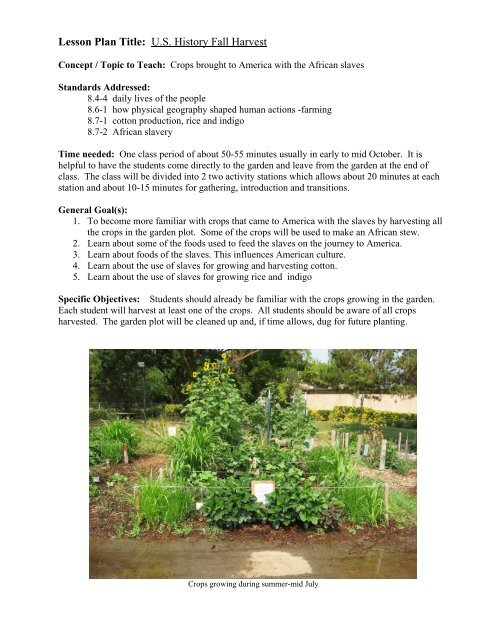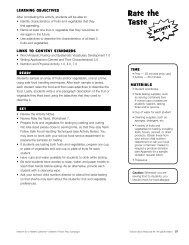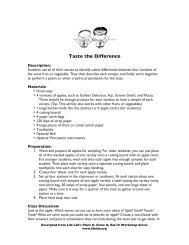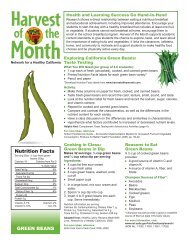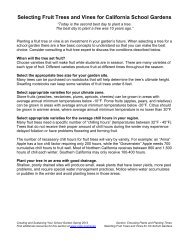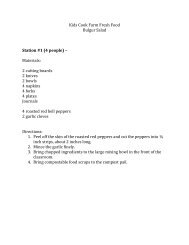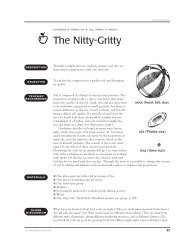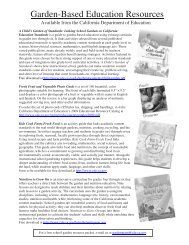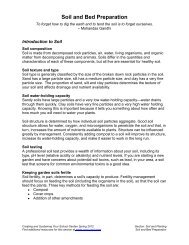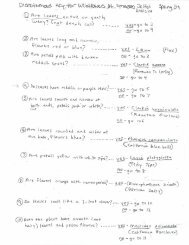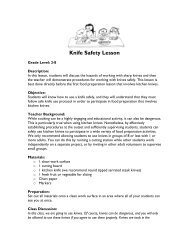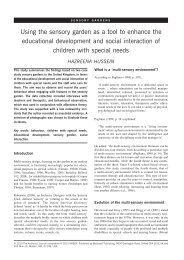Lesson Plan Title: U.S. History Fall Harvest
Lesson Plan Title: U.S. History Fall Harvest
Lesson Plan Title: U.S. History Fall Harvest
- No tags were found...
Create successful ePaper yourself
Turn your PDF publications into a flip-book with our unique Google optimized e-Paper software.
<strong>Lesson</strong> <strong>Plan</strong> <strong>Title</strong>: U.S. <strong>History</strong> <strong>Fall</strong> <strong>Harvest</strong>Concept / Topic to Teach: Crops brought to America with the African slavesStandards Addressed:8.4-4 daily lives of the people8.6-1 how physical geography shaped human actions -farming8.7-1 cotton production, rice and indigo8.7-2 African slaveryTime needed: One class period of about 50-55 minutes usually in early to mid October. It ishelpful to have the students come directly to the garden and leave from the garden at the end ofclass. The class will be divided into 2 two activity stations which allows about 20 minutes at eachstation and about 10-15 minutes for gathering, introduction and transitions.General Goal(s):1. To become more familiar with crops that came to America with the slaves by harvesting allthe crops in the garden plot. Some of the crops will be used to make an African stew.2. Learn about some of the foods used to feed the slaves on the journey to America.3. Learn about foods of the slaves. This influences American culture.4. Learn about the use of slaves for growing and harvesting cotton.5. Learn about the use of slaves for growing rice and indigoSpecific Objectives: Students should already be familiar with the crops growing in the garden.Each student will harvest at least one of the crops. All students should be aware of all cropsharvested. The garden plot will be cleaned up and, if time allows, dug for future planting.Crops growing during summer-mid July
Required Materials:Those marked with * should be found in garden shed – but don’t count on it.gloves * permanent markers to label harvest *scissors to cut twine * white plastic labels, cut in ¼, to label harvest *tables*compost bins with room for plant materialpruning shears for harvest * 5 gallon black bucket for pulled plant labels *example of a neatly tied bundle of grains * digging forks *cardboard box lids for harvesting cowpeas twine/jute, hole punch to label harvest *ziplock bags for calaloo and okra 5 gallon black buckets for garden cleanup *examples for activity station - dried okra seeds, fresh and dried okra pods, millet, sorghum,taro, manioc, cotton, peanut plant with peanuts, broom corn. (*there may beexamples in shed)Information and notes about African crops and slave cuisine. Also about picking cotton.Previous year’s garden plot plan for referencePreparation prior to the garden day:1. Get needed garden volunteer(s) and make sure other classes won’t be in the garden at thesame time. Check in with the Carden Coordinator or Garden Team Leader to get on thecalendar.2. Make sure the harvest day is not just after the garden is watered. It is best to harvest whenthe grains and paths are dry.3. Review the Summary of Crops for 8 th Grade for harvesting tips. Don’t assume the plot planwas followed and that the crops were planted as shown. Make sure each crop can beidentified.4. Decide number of crops to be harvested and the number of students in each rotation. Thisdetermines how many students will harvest each crop. Students usually like to work in pairsor groups of 3 students. Flexibility is always in order here!!5. The first rotation of students will harvest some of the crops and the second rotation the rest.Choose the crops to be harvested to give the students room to move around and work. It isimportant to think through a plan for harvest.6. Decide how and where the harvest will be stored. It is nice to at least have an example ofeach of the crops in the classroom.7. During summer, keep the okra picked when small and dry them in shed. Let one plant ofokra in each plot go to seed. Keep the calaloo cut back to avoid going to seed and to keepnew leaves coming.Anticipatory Set (Lead-In): At previous class meeting, explain what we will be doing in thegarden, harvesting the plants that were brought with African slaves to America. <strong>Harvest</strong>ed cropswill be used to make an African stew. Remind students to meet in the garden with appropriateclothes and shoes.Set up:1. Set up table near the garden plot with scissors, twine, hole punch, markers, and plasticlabels for bundling and identifying grains. Have an example of a neatly tied and labeledbundle.2
2. Set up table near the garden plot with pruning shears. Have bucket of gloves out and acouple digging forks3. Set up table for the second activity with examples of foods from Africa, cotton, etc. Thistable will be near the sitting/gathering area. Okra, fresh, dried and seeds. Millet sprays,sorghum, broom corn, taro, manioc, peanuts still on plant. Make sure notes are available tolead discussion. Have a stalk of sweet sorghum cut and ready to eat.Okra white cotton with fiber and bolls dried cow peasStep-by-Step Procedures:1. As students arrive, have them put their backpacks in an area out of the way. Designate agathering area.2. When the class has gathered, give an overview of the day’s activities. The class will bedivided into 2 stations so everyone will do both activities. Explain that everyone willhelp with the harvest.3. Crops need to be harvested in an organized and safe manner. Stress safe use of diggingforks and pruning shears. If the tools are not being used safely, they will be taken away.There will be no second chances!!4. Divide class into 2 stations. Note the time for changing stations.5. <strong>Harvest</strong>ing Station.It always works best to explain everything to the whole group at once as there is lessexplaining to do and students seem to listen better before they start to work. Explainexactly what you want to happen and how. Demonstrate if possible. Show students thearea by the shed where you want all the harvested crops to go. This explanation shouldonly take a few minutes – but the students need to know what to expect.. The studentsare always excited to get going.a. The harvest should be very controlled – not chaos.b. Show plot to be harvested. May want to review crops in plot by pointing to acrop so the student can say what it is. Do this very quickly as the students needand want to get to work.3
c. Have students pair up, etc to get the number of needed groups.d. Decide who will harvest what. Can ask “who wants to harvest rice?” and takefirst response. This is a risky, but usually satisfying method. Can just assigncrop to harvest. “You two will be harvesting the rice. OK?” Be specific withinstructions. “Do you know were the rice is?” “<strong>Harvest</strong> it all.” Or, “ harvestonly half of it.”e. If a crop can be pulled out (or cut at ground level) and processed away from thegarden plot this will help with congestion.f. Encouragement and comments on tasks well done always helps keep studentshappy and working. Make this fun but also productive.g. If someone finishes early, make sure plots are cleaned and ready to dig. Ifpossible have some of the students dig with a digging fork- or they may dig anarea of an other class that has already been harvested. Demonstrate proper useof digging fork. If a crop still needs to be harvested, ask students for help. Mostare willing to help but need direction!Processing cowpeasharvested sweet potatoesStudents using digging fork to dig up plot. Other students are harvesting and processing crops.4
Processing sweet sorghum. Bundling grain, removing leaves, will cut stalk into pieces to eat.Sorghum growing in the background.5
harvesting finger and pearl millet6. Activity station.a. This station can really be any activity or discussion. Some may have alreadybeen covered on a short garden visit. Some can be easily done in class anotherday. Below are some ideas.b. Have examples of millet, sorghum, taro, manioc, etc. and talk about what slavesate on ships to America.Http://www.slaveryinamerica.org/history/hs_es_cuisine.htm is a good startingsite for information.c. Talk about the use of slaves for growing and harvesting cotton. Read thefollowing passage“It was work hard, git beatins and haf fed… . The times I hated most waspickin’ cotton when the frost was on the bolls. My hands git sore and crackopen and bleed.” --Mary Reynolds, Slave Narrative from the FederalWritters’ Project, 1936-1938.A normal field hand was expected to be able to pick 150 to 200 pounds ofcotton per day. Some enslaved workers were known to pick as much as 500pounds daily.They always harvested cotton, moreover, in the heat of late summer,commonly under a blazing sun. They had to work fast to make their quota,and they had to work carefully so as not to introduce too much dirt or trashinto the bags. Woman and children were often valued as pickers because oftheir ability to pick clean cotton, meaning cotton free of stems or trash; andbecause they did not have to stoop quite so low as men, they suffered lessback pain.6
Show the sharp points on the cotton bolls and have the students touch them.Class will process the cotton in the winter.d. Talk about the use of okra. Seeds for coffee substitute, thickener, abortions, etc.e. Talk about sorghum (called guinea corn) and the three uses (grain, brooms andsweetener). Have the students sample sweet sorghum by peeling off the outercovering and sucking on the sweet inner core.f. Talk about peanuts, their other names and how they were cooked and eaten.There is a song sung during the Civil war.http://kids.niehs.nih.gov/lyrics/gooberp.htmCan hear the song –music- on this site as well.Show on map how the peanuts went from the new world to Africa and back tothe colonies. (Origin in S. America, taken to Europe by the Portuguese, then toW. Africa, then to the colonies with the slaves)Peanuts grow under the ground. The yellow flower is pollinated and then produces a peg thatgrows into the ground where the peanut is produced. These plants are drying a few days on the fence.Closure (Reflect Anticipatory Set):1. View display of harvested crops. Any comments about harvest from students?2. Have students help carry crops to classroom or storage area.Compiled by Patricia Carpenter updated October 20087


